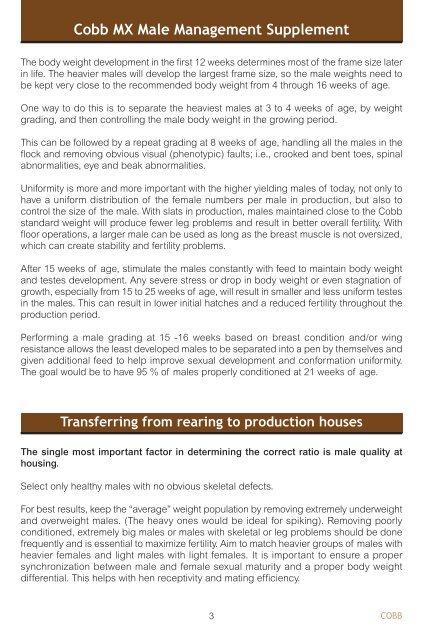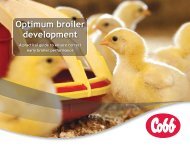breeder
2jt3bjj
2jt3bjj
Create successful ePaper yourself
Turn your PDF publications into a flip-book with our unique Google optimized e-Paper software.
Cobb Mx Male Management Supplement_Layout 1 29/03/2016 07:55 Page 5<br />
Cobb MX Male Management Supplement<br />
The body weight development in the first 12 weeks determines most of the frame size later<br />
in life. The heavier males will develop the largest frame size, so the male weights need to<br />
be kept very close to the recommended body weight from 4 through 16 weeks of age.<br />
One way to do this is to separate the heaviest males at 3 to 4 weeks of age, by weight<br />
grading, and then controlling the male body weight in the growing period.<br />
This can be followed by a repeat grading at 8 weeks of age, handling all the males in the<br />
flock and removing obvious visual (phenotypic) faults; i.e., crooked and bent toes, spinal<br />
abnormalities, eye and beak abnormalities.<br />
Uniformity is more and more important with the higher yielding males of today, not only to<br />
have a uniform distribution of the female numbers per male in production, but also to<br />
control the size of the male. With slats in production, males maintained close to the Cobb<br />
standard weight will produce fewer leg problems and result in better overall fertility. With<br />
floor operations, a larger male can be used as long as the breast muscle is not oversized,<br />
which can create stability and fertility problems.<br />
After 15 weeks of age, stimulate the males constantly with feed to maintain body weight<br />
and testes development. Any severe stress or drop in body weight or even stagnation of<br />
growth, especially from 15 to 25 weeks of age, will result in smaller and less uniform testes<br />
in the males. This can result in lower initial hatches and a reduced fertility throughout the<br />
production period.<br />
Performing a male grading at 15 -16 weeks based on breast condition and/or wing<br />
resistance allows the least developed males to be separated into a pen by themselves and<br />
given additional feed to help improve sexual development and conformation uniformity.<br />
The goal would be to have 95 % of males properly conditioned at 21 weeks of age.<br />
Transferring from rearing to production houses<br />
The single most important factor in determining the correct ratio is male quality at<br />
housing.<br />
Select only healthy males with no obvious skeletal defects.<br />
For best results, keep the “average” weight population by removing extremely underweight<br />
and overweight males. (The heavy ones would be ideal for spiking). Removing poorly<br />
conditioned, extremely big males or males with skeletal or leg problems should be done<br />
frequently and is essential to maximize fertility. Aim to match heavier groups of males with<br />
heavier females and light males with light females. It is important to ensure a proper<br />
synchronization between male and female sexual maturity and a proper body weight<br />
differential. This helps with hen receptivity and mating efficiency.<br />
3<br />
COBB





